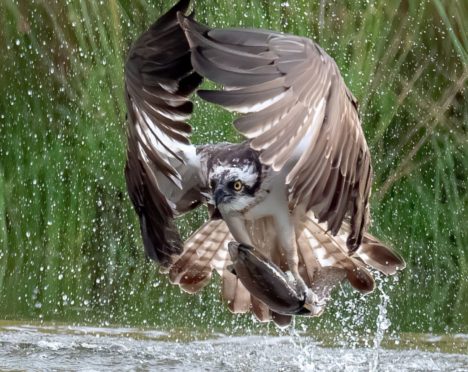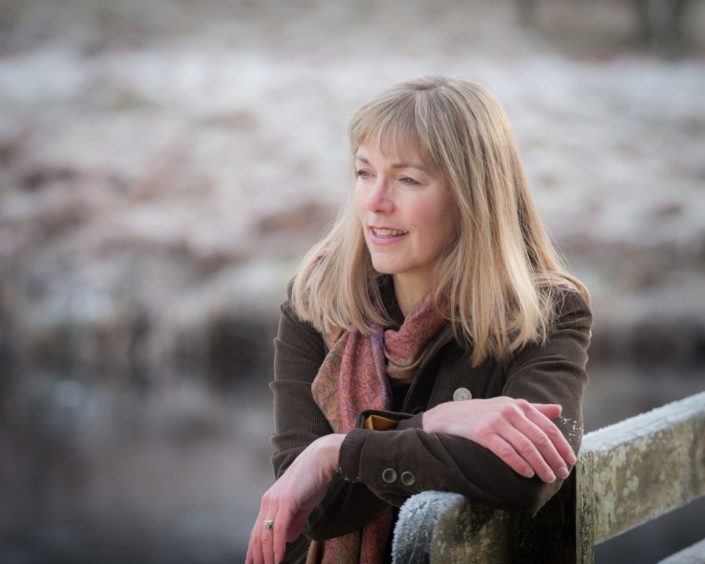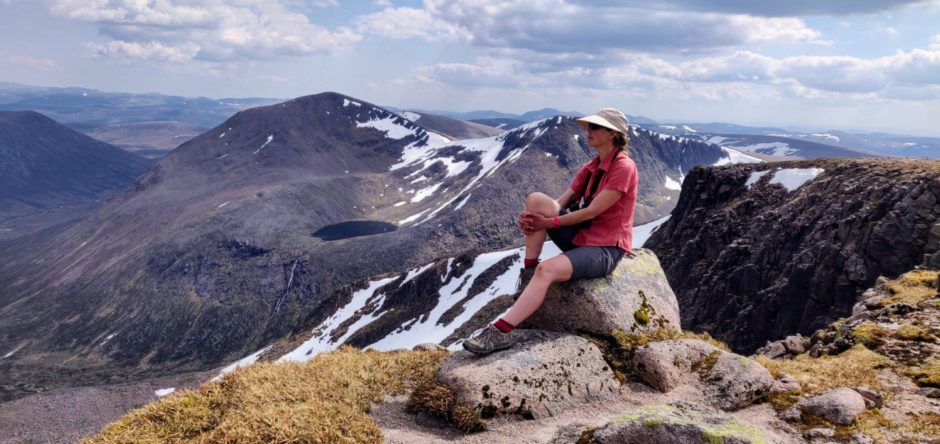
I am woken ridiculously early by the light spearing round the sides of the blackout blind and through my eyelids. At 6.30 it finally prises me out of bed and propels me to walk.
On my doorstep, I look east to the sun cresting the top of the Feshie Hills into a clear sky. Three oystercatchers hightail it overhead, making their beeping calls, and our resident blackbird flaps up to the chimney pot with an answering warble.
In the bare aspens by the railway line, I am stopped by a crazy, constantly changing tune and my binoculars find a song thrush, its dappled breast softly shining.
Moving on through the woods, an orchestra warms up with all the cheeps, whistles, pips and hoots of unnumbered birds: the robins, doves, chaffinches, crows, pigeons, tits, wrens and more. Some flit across my way, others perch high on spindly branches, while others remain hidden in the dark canopy of the evergreens.
I am a writer, living in Badenoch, the wide strath where the River Spey is born and begins its looping, languorous journey to the sea. When we first moved from Stirling to this fold of the Cairngorms 15 years ago, I didn’t know much about the flora or fauna of the area.
I knew the place was beautiful and special, and held so much we wanted for raising our young sons, but I didn’t understand quite how remarkable it was. Gradually, as I have explored deeper, further and higher – climbing up into the mountains, wandering far along glens and corries, biking through forests, swimming and boating the lochs and rivers – I have discovered more and more dimensions to this place. Most importantly, I have learned to explore by doing nothing but sitting. This past year of Covid restrictions, in particular, has taught me how much comes from stillness.
Slowly, the story of this landscape, its living creatures and growing things has grown in me and out of me into my writing. Like any author, I have always kept journals, filled with everything from scrappy notes, poems, beginnings of fiction and the occasional record of my strange dreams.
But since moving here, ever more of the pages have been given over to capturing my outdoor experiences. Nature is colonising my notebooks. I started a folder divided by months and wrote observations at my kitchen table when I got back from walks, building a layered seasonal record. Looking back, the early entries were focused mainly on landscape, weather and trees, and there were few birds I knew on a first-name basis.
Latterly, I am learning the birds. Not just their names but their voices and the patterns of their flight. I now have binoculars and a field notebook that I take with me to capture what’s happening as I see it, lest I forget. And I do forget.
I may witness a raucous murder of crows in the ancient oaks, but if I do not note it down, it recedes into the general blur of bird and bush. And the taking note means the living world is taking shape. What used to be little more than undistinguished brown fluttering things are becoming distinct and recognisable creatures. Now I don’t just see a bird, I see the flash of citrine green on its back feathers and the gold of its eye.
On this day, once I get down to the lochside, it feels like holy ground. The grass is still furred with frost that twinkles in the sun like a scattering of glitter, tiny sparks of red, blue and green. A breath of mist rises off the marshland where even haggard tree stumps and fallen logs are graced by light.
At my favourite spot, I look across the water to an island massed with trees and crowned at one end by a large, craggy nest. It is the home of the ospreys. They have, once again, made their astonishing journey from west Africa to these waterways in Scotland to breed, flying alone but usually returning to the same nest and the same partner.
For me, watching their summertime domestic arrangements is better than any television soap opera. The whole loch becomes part of the drama, as more and more migrants arrive and fight feather and claw for territory, a mate, some food, safe hatching and survival. But you won’t notice any of it unless you pay attention.
I, too, am a migrant, though a lucky one as I don’t need to fight to get by. An Australian citizen, I was born in Kathmandu and grew up in Nepal, India and Pakistan.
I had the privilege of moving through many striking landscapes, but never stayed long enough – or paid attention long enough – to gain a deep knowledge about the flora and fauna.
My house here by the Spey is the longest I have lived anywhere in the world and it has become another kind of journey – rather than exploration across a wide geography, it is a journey of depth into one place. But the more you know, the more you know you don’t know.
I am not remotely expert and doubt I ever will be; I am, and will probably remain, a besotted beginner.
Perhaps because I have moved so much, a sense of place has always been important in my writing. Words are a powerful way to hold on to a place, to take it with me and remember it, woven into the fabric of my life. My first novel, A House Called Askival, was set in the mountains of north India where I went to school, but was written in Scotland. The writing was a way of reaching back, of summoning again the lost spirits of that time and place. My second novel is set here in the Cairngorms, and was written here.
Seven years after we moved, the rising sun was up to its tricks again. It was the summer solstice and that time it got me out of bed at 4am and made me write. These were the first words: “A story. A land. A people. This place of beauty and history, of loss and hope. A shepherd.”
From the beginning, it was clear how much that story was about the landscape, the wildlife and the plants, as much as the people. But the people are part of the landscape and it is part of them. It is a story about how the two cannot be separated, how they have shaped each other, for better or worse, for these thousands of years. It is a story about how both people and land need healing.
That story has become Of Stone And Sky, which is launching on Thursday. In the novel, the shepherd, who has just finished lambing, suddenly disappears, leaving a strange trail of his possessions up into the Cairngorm mountains. Driven to discover the forces that led to his vanishing, his foundling sister and prodigal brother tell a story that circles out to embrace the entire community, its history and the landscape that shapes them. Both a mystery and a political challenge, it is a story of love, loss and redemption.
In 2019, as the work of writing the novel was coming to a close, I got my dream job as writer in residence for the Cairngorms National Park.
Across that year and across the vast span of the Park, I led workshops with all kinds of people, listening to their stories of life in this exceptional place, their encounters with bird and beast, their wanderings in mountain, waterway and forest.
I encouraged participants to think not just about flora and fauna but about people, too. We are natural. We belong here. We are not alien invaders or an invasive species, though we behave like both too much of the time. We need to learn what it means to be part of nature and not at odds with it.
Out of the National Park residency, the publisher Polygon made me an irresistible invitation: to write a contemporary response to Nan Shepherd’s The Living Mountain. Her classic work has come to be regarded as one of the finest books on landscape and nature in the UK and I’ve now read it multiple times. Just like walking in this place, every return reveals new things. This daunting but profoundly joyous project has become a kind of love letter back to her and the mountains she treasured so deeply. Called The Hidden Fires: A Cairngorms Journey With Nan Shepherd, that book is due out in spring 2022.
And so there is a three-way conversation. One part is me, with my notebooks and my laptop; the second is Nan Shepherd and the many other writers, naturalists and Cairngorms-wanderers who are teaching me to better see and understand this place; and the third is the landscape itself, the living world, the birds and the beasts who are speaking tales strange, beautiful and true, if only I have ears to hear.
Merryn Glover’s first novel, A House Called Askival, was published in 2014. She has written four plays for BBC Radio 4 and Radio Scotland and numerous short stories. Australian by passport, international by heart, she lives in the Highlands and has called Scotland home for more than 25 years.
Of Stone And Sky is published by Polygon on Thursday. Digital launch bookings at bit.ly/3tpn1PA For more, see merrynglover.com

Enjoy the convenience of having The Sunday Post delivered as a digital ePaper straight to your smartphone, tablet or computer.
Subscribe for only £5.49 a month and enjoy all the benefits of the printed paper as a digital replica.
Subscribe © Stewart Grant
© Stewart Grant